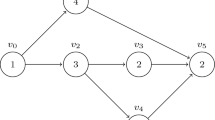Abstract
In this paper, we consider the problem of going from high-level specifications of complex control tasks for cyber-physical systems to their actual implementation and execution on physical devices. This transition between abstraction levels inevitably results in a specification-to-execution gap, and we discuss two sources for this gap; namely model based and constraint based. For both of these two types of sources, we show how hybrid control techniques provide the tools needed to compile high-level control programs in such a way that the specification-to-execution gap is removed. The solutions involve introducing new control modes into nominal strings of control modes as well as adjusting the control modes themselves.







Similar content being viewed by others
Notes
Since our Lyapunov functions are conservative estimates of the region of attraction around each point, it may still be possible to execute an MDL string even if \(\sigma \notin \mathcal{F}\).
References
Archer B, Sastry S, Rowe A, Rajkumar R (2009) Profiling primitives of networked embedded automation. In: Proceedings of the fifth annual IEEE Conference on Automation Science and Engineering (CASE 2009)
Bicchi A, Marigo A, Piccoli B (2006) Feedback encoding for efficient symbolic control of dynamical systems. IEEE Trans Automat Contr 51(1):1–16
Brockett RW (1988) On the computer control of movement. In: Proceedings of the 1988 IEEE conference on robotics and automation. New York, pp 534–540
Burridge RR, Rizzi AA, Koditschek DE (1999) Sequential composition of dynamically dexterous robot behaviors. Int J Rob Res 8(6):534–555
Chen Y, Ding XC, Stefanescu A, Belta C (2010) A formal approach to deployment of robotic teams in an urban-like environment. In: 10th international symposium on Distributed Autonomous Robotics Systems (DARS). Lausanne, Switzerland
Egerstedt M, Wardi Y, Axelsson H (2006) Transition-time optimization for switched systems. IEEE Trans Automat Contr 51(1):110–115
Frazzoli E, Dahleh MA, Feron E (2005) Maneuver-based motion planning for nonlinear systems with symmetries. IEEE Trans Robot 21(6):1077–1091
Klavins E (2003) A formal model of a multi-robot control and communication task. In: 42nd IEEE conference on decision and control
Manikonda V, Krishnaprasad PS, Hendler J (1998) Languages, behaviors, hybrid architectures and motion control. In Willems JC, Baillieul J (eds) Mathematical control theory. Springer-Verlag
Martin P, Egerstedt M (2009) Optimization of multi-agent motion programs with applications to robotic marionettes. Hybrid systems: computation and controll. Springer-Verlag
Martin P, Egerstedt M (2010a) Expanding motion programs under input constraints. In: Proceedings of American control conference. Baltimore, Maryland
Martin P, Egerstedt M (2010b) Timing control of switched systems with applications to robotic marionettes. JDEDS 20(2):233–248
Motion Description Languages (2010) On the specification and execution of motion programs for networked systems. In: 19th international symposium on mathematical theory of networks and systems
Stankovic J, Lee I, Mok A, Rajkumar R (2005) Opportunities and obligations for physical computing systems. Comput 38(11):23–31
Twu P, Martin P, Egerstedt M (2010) Graph process specifications for hybrid networked systems. International Workshop on Discrete Event Systems (WODES). Berlin, Germany
Author information
Authors and Affiliations
Corresponding author
Rights and permissions
About this article
Cite this article
Martin, P., Egerstedt, M.B. Hybrid systems tools for compiling controllers for cyber-physical systems. Discrete Event Dyn Syst 22, 101–119 (2012). https://doi.org/10.1007/s10626-011-0117-8
Received:
Accepted:
Published:
Issue Date:
DOI: https://doi.org/10.1007/s10626-011-0117-8




